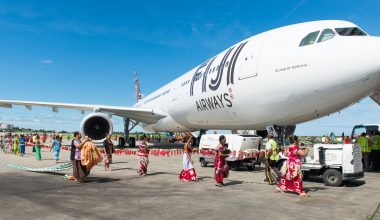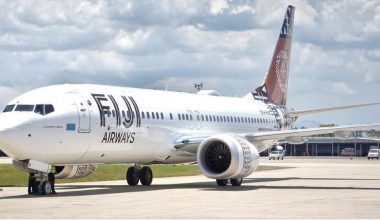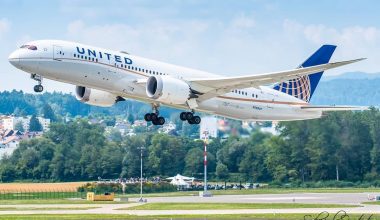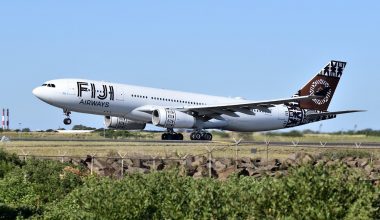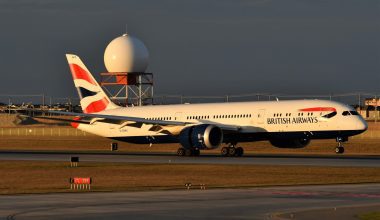Air New Zealand, the flag carrier of New Zealand, will withdraw its Boeing 777-300ERs in favor of moving towards a sole Boeing 787 fleet for its post-pandemic flight operations. In the midst of its ambitious transformation, Air New Zealand is focusing on the induction of advanced all-new super-efficient aircraft Boeing 787 Dreamliners on long-haul routes to Asia and North America.
The state flag carrier owns a fleet of seven Boeing 777-300ERs and 14 Boeing 787-9s at present. But two of 777-300ERs will soon join the rank of aircraft Air New Zealand no longer flies by 2025 as Boeing 787-10 Dreamliners will replace them. The carrier has made an order for 8 Boeing 787 aircraft slated to be delivered by 2027.

The chief financial officer of Kiwi Carrier, Mr. Richard Thomson, stated that the airline is set to welcome ‘Dash 10’ Dreamliners which will handle all of its long-haul flights and will put out the fleet of 777-300ERs to the ground.
Following the financial result of Air New Zealand in 2021, the carrier announced the accumulated loss of US 289 Million in the first half of this year. The course of pandemic took US 454 million in 2020. This was the first annual loss accumulated by the airline in the last 18 years.
Farewell to Boeing 777-300ERs
As Air New Zealand is in the midst of a radical fleet shakeup, the financial result of the airline, along with its shocking announcement, made it clear that there is no place for seven of its Boeing 777-ERs in the future. Until the pandemic hit the aviation industry, Air New Zealand was operating Boeing 777-200 and 777-300 variants. It has already withdrawn all Boeing 777-200 variants that were leased due to unfavorable circumstances induced by the pandemic. Some of these variants are for sales, while others will be turned into scrap.
Looking at the history of Kiwi 777-300ER, the first such type joined the fleet at its 2010 end, five years after the delivery of the first 777-200ER since the fleet age is just about nine years. As such, one can predict, at least some of these aircraft to be utilized for other purposes, even if it is converted into cargo planes because it’s saddening that aircraft having a high potentiality and less utilization is near to see its future at pasture.

These triple sevens entered the fleet with the exit of 747-400s to operate on transpacific routes. They were once a daily sight on routes like Auckland-Los Angeles and London. These aircraft variants flew on two liveries; one had a white front, black end. The other livery included prominent ‘all blacks.’
Also Read: Boeing 777-200 with 278 passengers narrowly escapes collision with drone
The 777 fleets of Air New Zealand consisted of four owned and four leased 777-300ERs, all of them having distinctive fern liveries. As international air travel came to a near still in 2020 due to the swift flow of the Coronavirus pandemic, Air New Zealand grounded its 777 aircraft and put them on the US desert storage facilities. Last year, the airline announced that it wouldn’t return the 777 aircraft to service until at least September this year, i.e., 2021. The resurgence of COVID cases created a highly volatile situation. So, no passenger flights were conducted with Boeing 777 aircraft as they took extended vacations from flying. The airline instead preferred to use 787 Dreamliner for catering passengers on its slimmed-down scheduled flights.
Why not Boeing 777-300ERs?
Normally, Air New Zealand flies the fleet of Boeing 777 and 787 for its long-haul international flights. Boeing 777-300 ER is bigger than the Dreamliners in terms of seating capacity. While 777-300 ER can accommodate 342 passengers, the seating capacity of the Dreamliners ranges between 275 and 302, depending on the configuration. Given no roadmap on when international travel will recover, Air New Zealand executive teams shifted their attention to operational agility and efficiencies.
So, as long-haul travel won’t return to the pre-pandemic level anytime soon with passengers opting to travel on short-haul routes initially, it’s easier and economical for Air New Zealand to fill the small long-haul aircraft (787) than bigger Boeing 777-300ERs.

Boeing 777 will exit Air New Zealand’s fleet by 2027. As a part of the major restructuring program, the Dreamliners will replace the 777-300 fleet from 2024. The original plan of the airline was to ground only 777-200s, but the impact of the COVID-19 accelerated the fleet simplification plan. By the end of this decade, 777-300s will say goodbye.
Boeing 787 Dreamliners have more operational efficiencies than Boeing 777s, as they are cost-effective than the latter ones. Every penny counts in this situation of turmoil; therefore, Air New Zealand is focused on running the Dreamliners now. The airline has centered its future long-haul flights on the Dreamliners. Two-third of airline revenue comes from launching international flights. In such a scenario, the Dreamliners fit perfectly in the environment of the prevalent pandemic as Air New Zealand’s fleet transformation focuses much on cutting costs.
Dreamliners as the backbone of Air New Zealand’s new fleet
Dreamliners are the epitome of advanced technological development in aviation. Not only are they fuel-efficient, but they also generate benefits for the airline in terms of its operation in the areas like engineering and maintenance, flight operations, crew management, etc.
Air New Zealand is currently pursuing the goal of having a simplified fleet of the only A320 family and Boeing 787 Dreamliners-they both are neat and cut aircraft for the airline’s current business strategy to ensure the best efficiency. The long-haul fleet of this carrier will include Boeing 787-9 and Boeing 787-10 (the first aircraft of 787-10 is scheduled to be delivered in 2024).

Business-class of Air New Zealand’s new Boeing 787-10s
Air New Zealand will introduce its all-new business class seats along with the ‘business plus’ section in the new Boeing 787-10s. The front row cabin will provide myriad offerings to its business class customers, including extra legroom, space, and privacy plus ( Shared dining experience) that will enhance the customer’s flying experience at Air New Zealand’s business class. This service will demand high prices or frequent flyer points.
The current Boeing 787-9s will start to require an upgrade on its interiors, requiring more Cap-Ex, although the airline hasn’t yet decided the timeline on this upgrade.
Air New Zealand’s current fleet
At present, Air New Zealand operates five aircraft types that include:
- Boeing 787-9 Dreamliner (14)
- Airbus A320s (20)
- A320/321 neo aircraft (11)
- ATR 72-600s (28)
- Bombardier DHC-8-300s (23)
The 7 Boeing 777-300ERs and 8 Boeing 777-200 aircraft are not in service and are kept in storage.
Also Read: New Zealand approved the return of Fiji Airways 737 MAX to its skies
Air New Zealand’s ongoing situation
The nationwide lockdown as a result of the widespread outbreak of the COVID-19 in Auckland reflected the inability of Air New Zealand to fly two-thirds of its passenger network. The dramatic drop in passenger demand has posed a threat to the viability of the airline as no finely-tuned balance is found between incurred losses and incoming revenue induced by coronavirus transmission worldwide. The airline is operating a pretty skinny schedule on its domestic network and is not catering to the passengers in the regions as a consequence of alert level change. The airline is hoping to conduct international long-haul flying with the massive surge in vaccination doses. The airline is preparing to face the new normal in a different position as people start holidaying again. The Kiwi carrier is focusing on offering more lower-priced fares in the domestic network, intending to unlock new demand in domestic tourism while increasing the choice of flight time for the passengers.
About Air New Zealand
Air New Zealand is the flag carrier of New Zealand based in Auckland and founded on 26 April 1940. Flying across the extensive network of 20 domestic and 32 international destinations in 20 countries, the airline flies more than 17 million passengers every year (before pandemic). It transports both passengers and cargo in the domestic network between twenty New Zealand regions by which it has built its resilient core domestic business. It operates direct flights to the major Pacific Rim and beyond.

Air New Zealand is a member of Star Alliance, and it is well-known for its on-time performance with major records on well-timed arrival and departures. It is focused on sustainable cost improvements through the operation of modern fuel-efficient aircraft.
About Dreamliner
Boeing 787 Dreamliner is a long-haul, widebody twin-engine jetliner of Aerospace giant Boeing, known for its unparalleled fuel efficiency and range flexibility. Equipped with low swept-back wings and two underwing pylon mounted engines, the aircraft has lightweight. It has an easy pilot transition, wider windows, with its composite less vulnerable to corrosion.
Boeing 787-9 Dreamliner can carry about 270 people; the replacement of Boeing 767-400ER. Similarly, Boeing 787-10 has a seating capacity of up to 300 people. This variant will provide competition to Airbus A350. Air New Zealand will seek to receive significant cost savings by shifting to Boeing 787 Dreamliners.


